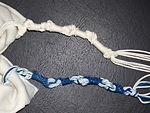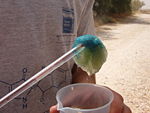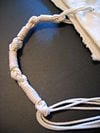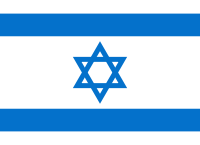Tzitzit
Tzitzit or tzitzis (Ashkenazi) (Biblical Hebrew language: ציצת, Modern ציצית) are "fringes" or "tassels" worn by observant Jews on the corners of four-cornered garments, including the tallit (prayer shawl). This practice is derived from biblical commandments found in the books of Numbers and Deuteronomy (Num 15:38, Deut 22:12. The Jewish sage Maimonides includes wearing the tzitzit as a major mitzvah (commandment) along with brit milah (circumcision) and the korban pesah ("Paschal lamb").[1]
In Orthodox Judaism, tzitzit (plural: tzitzyot) are worn only by men in remembrance of God's presence in the world and the importance of keeping all 613 commandments. Rashi, a prominent Jewish commentator, claimed that the number of knots in a tzitzit has the numerical value of 613, reminding the wearer to follow all of the Torah's 613 commandments. Additionally, the tekhelet dye (a blue colored dye) traditionally used in the creation of a tzitzit was said to inspire the design for the modern flag of Israel.
Many religions imbue clothing with religious significance as a sign of respect before God. Religious vestments convey the message that daily practice requires purity and cleanliness as well as constant remembrance of the divine's blessings and commandments.
Biblical sources
The Torah states in Numbers 15:38: "Speak to the children of Israel, and say to them, that they shall make themselves fringes on the corners of their garments throughout their generations, and they shall put on the corner fringe a blue (tekhelet) thread."
Wearing the tzitzit is also commanded in Deuteronomy 22:12, which says: "You shall make yourself twisted threads, on the four corners of your garment with which you cover yourself."
Traditional Jews wear a tallit katan (small prayer shawl) constantly in order to fulfill this commandment as some consider it a transgression to miss a commandment that one has the ability to fulfill. The tallit katan is also commonly referred to as "tzitzit," though this name technically refers to each of the fringes only.
Tying of knots
There are numerous customs as to how to tie the fringe. The Talmud mentions an upper knot (kesher elyon) and one wrapping of three winds (hulya). It states that between seven to 13 hulyot be tied, and that "one must start and end with the color of the garment." As for the making of knots in between the hulyot, the Talmud is inconclusive, and as such poskim ("decisors of Jewish law") have varyingly interpreted this requirement. The fringe (tzitzit) on each corner is made of four strands with eight fine threads each (known as kaful shemoneh). The four strands are passed through a hole (or according to some, two holes) that are a couple of inches away from the corner of the cloth. The Talmud also described using tekhelet dye, however, following the loss of the source of the dye, various customs of tying were introduced to compensate for the lack of this primary element.
Though many methods exist of tying the tzitzit, the one that gained the widest acceptance can be described as follows:
The four strands of the tzitzit are passed through holes near the four corners of the garment (Shulchan Aruch Orach Chaim 11:9-11, 15) that are farthest apart (10:1). Four tzitzyot are passed through each hole (11:12-13), and the two groups of four ends are double-knotted to each other at the edge of the garment near the hole (11:14, 15). One of the tzitzit is made longer than the others (11:4); the long end of that one is wound around the other seven ends and double-knotted; this is done repeatedly so as to make a total of five double knots separated by four sections of winding, with a total length of at least four inches, leaving free-hanging ends that are twice that long (11:14).
Before tying begins, a Hebrew blessing is said (it's more of a "declaration of intent"): L'Shem Mitzvat Tzitzit ("for the sake of the commandment of tzitzit"). Some rabbis are of the opinion that one should instead say a full blessing: Baruch atah Adonai Elohainu Melech HaOlam, asher kiddishanu b'mitzvotav v'tzivanu la'asot tzitzit ("Blessed are you, Lord, our God, King of the universe who sanctified us with His commandments and commanded us to make [the] tzitzit).

The two sets of stands are knotted together twice, and then the shamash (a longer strand) is wound around the remaining seven strands a number of times (see below). The two sets are then knotted again twice. This procedure is repeated three times, such that there are a total of five knots, the four intervening spaces being taken up by windings numbering 7-8-11-13, respectively. The total number of winds comes to 39, which is the same number of winds if one were to tie according to the Talmud's instruction of 13 hulyot of 3 winds each. Furthermore, the number 39 is found to be significant in that it is the gematria (numerical equivalent) of the words: "The Lord is One" (Deut. 6:4). Others, especially Sephardi Jews, use 10-5-6-5 as the number of windings, a combination that represents directly the spelling of the Tetragrammaton (one of God's names).
Rashi, a prominent Jewish commentator, bases the number of knots on a gematria: the word tzitzit (in its Mishnaic spelling) has the value 600. Each tassel has eight threads (when doubled over) and five sets of knots, totaling 13. The sum of all numbers is 613, traditionally the number of mitzvot (commandments) in the Torah. This reflects the concept that donning a garment with tzitzyot reminds its wearer of all Torah commandments.
Nachmanides disagrees with Rashi, pointing out that the Biblical spelling of the word tzitzit has only one yod rather than two, thus adding up to the total number of 603 rather than 613. He points out that in the Biblical quote "you shall see it and remember them," the singular form "it" can refer only to the "p'til" ("thread") of tekhelet. The tekhelet strand serves this purpose, explains the Talmud, for the blue color of tekhelet resembles the ocean, which in turn resembles the sky, which in turn is said to resemble God's holy throne—thus reminding all of the divine mission to fulfill God's commandments.
Color controversy
The Hebrew Bible tells Jews to wear tzitzyot colored with tekhelet. According to the Talmud, tekhelet (תכלת) which appears 48 times in the Tanakh—translated by the Septuagint as iakinthos (blue)—is a specific dye of blue produced from a creature referred to as a chilazon, other blue dyes being unacceptable (Tosefta). At some point in Jewish history, the source of the dye was lost and since then, Jews have worn plain white tzitzyot without any dyes. Some explain the black stripes found on many traditional prayer shawls as representing the loss of this dye.
In the last two centuries, a number of attempts have been made to identify the ancient source of the dye using relevant Talmudic sources and to resume dying the threads.
Generally speaking, the vast majority of Haredim continue to wear only white tzitzyot without any dye, following their poskim (decisors of Jewish law), most of whom maintain that it is better to use no dye at all rather than rely on uncertain scientific finds. Some, such as Rabbi Yosef Sholom Eliashiv, say that is problematic to wear the dyed string if it is not truly tekhelet. Others, including some religious Zionist poskim (particularly the group known as Hardalim), believe there is no objection to wearing colored strands, even if the color would not be the real tekhelet.
In remembrance of the commandment to use the tekhelet dye, it became common for Jews to have blue or purple stripes on their tallit.[2] It was what inspired the Zionist movement's design for the flag of Israel.
Three candidates have been proposed as the source of the dye. For various reasons, no candidate has been unanimously accepted by all though over the past decade the Murex trunculus (mollusk) dye has enjoyed great acceptance.
Chilazon
The chilazon is the animal from which the tekhelet dye was obtained by the ancient Israelites according to rabbinic tradition. An important description of the chilazon comes from the Talmud:[3]
- Its body is like the sea.
- Its creation is like a fish.
- It "comes up" once in 70 years,
- Its "blood" is used for tekhelet,
- Therefore: It is expensive.
Other criteria (with Talmudic references):
- The fishers of the chilazon are from Haifa to Tyre (Shabbat 26a)
- The color of the chilazon dye is identical to that produced from the dye of the kela ilan plant (Indigoferra tinctoria), which served as a counterfeit source of the dye (Baba Metzia 61b)
- Cracking open the shell of the chilazon on Shabbat violates the laws of Shabbat (Shabbat 75a)
- The shell of the chilazon grows together with it (Midrash Shir haShirim Rabbah 4:11)
- The blood of the chilazon is the color of tekhelet (Rashi, Tractate Chulin 89a)
- The blood of the chilazon is black like ink (Maimonides Hilchot Tzitzit 2:2)
- The chilazon buries itself in the sand (Megila 6a)
- It is an invertebrate (Jerusalem Talmud Sabbath 1:3 8a)
Sepia officinalis

In 1887 Rabbi Gershon Henoch Leiner (the Radzyner Rebbe) embarked on an extensive research program and found the Sepia officinalis (common cuttlefish) to meet many of the above criteria. This new tekhelet produced from this animal quickly caught on amongst the Rebbe's followers and within a year, 10,000 Radziner Hasidim wore the colored tzitzit. The dye also became popular amongst Breslov Hasidim (followers of Rabbi Nachman of Breslov). The vast majority of Orthodox Jewry, however, did not accept the Radzyner Rebbe's findings.
As part of his doctoral research, Rav Herzog corresponded with the Radzyner Hasidim regarding this dye and obtained the recipe for it. He had the recipe analyzed by chemists who informed him that it was virtually identical to the well known synthetic dye "Prussian blue" wherein the blue color results from iron filings, the cuttlefish merely supplying nitrogen which does not contribute to the color. With this information, R. Herzog rejected the cuttlefish as the chilazon. Indeed, had the Rebbe known this fact, he too would have rejected it, as he writes explicitly that the color must come from the animal, all other additives being permitted solely to aid the color to adhere to the wool (Ptil Tekhelet, 168).
Janthina

Within his doctoral research on the subject, Rabbi Herzog proposed that one could obtain blue from the Janthina snail ("violet snail," or "common purple sea snail").[4] "However, the dye produced by the Janthina turned brown, and was not permanent. It appears that Rabbi Herzog did not pursue this matter further."[5] Though blue dye has indeed been obtained from the Murex Trunculus snail, in 2002, Dr. S.W. Kaplan of Rehovot, Israel proclaimed that he was able to dye wool with the extract of Janthina.
Murex trunculus
The Murex trunculus, a sea snail, is popularly advanced as the source of the coveted dye. Rabbi Yitzhak HaLevi Herzog (1889–1959) wrote his doctoral thesis in 1913 on the subject and named the Murex snail as the most likely candidate for the dye's source. Though the Murex fulfilled many of the Talmudic criteria, his inability to consistently obtain blue dye (sometimes the dye was purple) from the snail precluded him from proclaiming that dye source had been found.
In the 1980s, Otto Elsner, a chemist from the Shenkar College of Fibers in Israel discovered that if a solution of the dye was exposed to sunlight, blue instead of purple was consistently produced. Eventually, in 1993, the Ptil Tekhelet Foundation was formed for mass production of this tekhelet, as well as to continue further research.
Karaite tzitzit
Karaites wear tzitzyot with blue threads in them. In contrast to Rabbinic Judaism, they believe that the tekhelet (the "blue") does not refer to a specific dye. The traditions of Rabbinic Judaism used in the knotting of the tzitzit are not followed, so the appearance of Karaite tzitzit can be quite different from that of Rabbanite tzitzit. Contrary to some claims, Karaites do not hang tzitzyot on their walls.
In Christianity
Tzitziot are found both in Christian scripture and in limited segments of Christian practice.
In the New Testament, Matthew 9:20-22 (NAS) records:
And a woman who had been suffering from a hemorrhage for twelve years, came up behind Him and touched the fringe of His (Jesus') cloak; for she was saying to herself, "If I only touch His garment, I will get well." But Jesus turning and seeing her said, "Daughter, take courage; your faith has made you well." At once the woman was made well.
Matthew 14:34-36 similarly records:
When they had crossed over, they came to land at Gennesaret. And when the men of that place recognized Him, they sent word into all that surrounding district and brought to Him all who were sick; and they implored Him that they might just touch the fringe of His cloak; and as many as touched it were cured.
Christian interpreters have connected these healings, that the New Testament records taking place through Jesus' tzitzit, with a prophecy in Malachi 4:2:
But for you who fear My name, the sun of righteousness will rise with healing in its wings...
Christian interpreters have stated that this is a messianic prophecy fulfilled by Jesus because the Hebrew word "corners" (kanafim, כנפים), used in the Torah for the place tzitzit are to be attached, literally means "wings." Therefore, interpreters say, the suffering woman and the others who were infirm found healing in Jesus' "wings."[6][7]
Matthew 23:5 also records Jesus saying:
"But they do all their deeds to be noticed by men; for they broaden their phylacteries and lengthen the tassels" of their garments.
The common interpretation of this statement is that while Jesus himself wore tzitzit, he explained that one should not do the commands of God in such a way as to be seen as more righteous and more zealous by others, which displays a prideful heart. In this case, this motivation was evident in the Pharisees to whom he spoke.[8][9]
While much of traditional Christianity has not considered Torah commands (such as tzitzit) applicable to Christians, there are Torah-submissive Christians who wear tzitzit out of obedience to Torah, imitation of Jesus, and in remembrance of Jesus' miracles. Like Karaites, Torah-submissive Christians generally do not feel bound to Jewish oral law, so tzitzyot may vary in appearance and may contain blue which is not halakhically derived. However, because of practicality and convenience, traditionally Jewish tzityot and tallits are often used.
In archaeology and secular scholarship
Some archaeologists and non-traditional secular biblical scholars speculate as to the source of the tradition. According to the modern documentary hypothesis, the reference to tzitzit in Numbers comes from the Priestly Code, while that from Deuteronomy to the Deuteronomic Code, and hence date to around the late eighth century B.C.E. and late seventh century B.C.E. respectively, some time after the practice began to be in use.[10] The custom, however, clearly predates these codes and was not limited to Israel; images of the custom have been found on several ancient Near East inscriptions, in contexts suggesting that it was practiced across the Near East.[11]
Some scholars believe that the practice among ancients originated due to the wearing of animal skins—which have legs at each corner—and that later fabrics symbolized the presence of such legs, first by the use of amulets, and later by tzitzit.[12] This explanation does not negate the Biblical commandment's use of such social elements to emphasize its own agenda. Indeed, tassels were used in the ancient world as an insignia as to the status of its wearer, often his rank within the court of the ruler. The tzitzit thus indicated that its bearer was a Jew.
Notes
- ↑ Comm. Pirkei Avot 2:1.
- ↑ Rabbi Shraga Simmons, Tallit stripes, About.com's "Ask the Rabbi." Retrieved February 3, 2008.
- ↑ Tractate Menachot 44a.
- ↑ Rabbi Isaac Herzog, "Hebrew Porphyrology," in Ehud Spanier, ed., The Royal Purple and the Biblical Blue: Argaman and Tekhelet (Jerusalem, 1987).
- ↑ Mendel E. Singer, "Understanding the Criteria for the Chilazon." Retrieved February 3, 2008.
- ↑ "Prayer Shawl and Bible Manners and Customs," Hope of Israel Baptist Mission. Retrieved February 3, 2008.
- ↑ Institute for Hebraic-Christian Studies, "The Hem of His Garment." Retrieved February 3, 2008.
- ↑ BibleGateway.com, Jesus reproves the scribes and Pharisees. Retrieved February 3, 2008.
- ↑ United States Conference of Catholic Bishops, New American Bible, Matthew 23. Retrieved February 3, 2008.
- ↑ Richard Elliott Friedman, Who Wrote the Bible? (Englewood Cliffs, NJ: Prentice Hall, 1987, ISBN 0671631616).
- ↑ Arthur S. Peake, Matthew Black and Harold Henry Rowley, Peake's Commentary on the Bible (London: Routledge, 2001, ISBN 0415263557).
- ↑ Ibid.
ReferencesISBN links support NWE through referral fees
- Bailey, Stephen. Kashrut Tefillin Tzitzit: Studies in the Purpose and Meaning of Symbolic Mitzvot Inspired by the Commentaries of Rabbi Samson Raphael Hirsch. Jason Aronson, 2000. ISBN 978-0765761064
- Herzog, Rabbi Isaac. "Hebrew Porphyrology," in Ehud Spanier, ed., The Royal Purple and the Biblical Blue: Argaman and Tekhelet. Jerusalem, 1987.
- Hillel, Yitshak Hertzel. Tzitzit, a Comprehensive Halachic Guide (Tzel Herharim Series). Feldheim Pub., 2006. ISBN 978-1583302927
- Robinson, George. Essential Judaism: A Complete Guide to Beliefs, Customs & Rituals. Atria, 2001. ISBN 978-0671034818
External links
All links retrieved May 2, 2023.
- "What are tzitzit?" by Rabbi Mendy Hecht, AskMoses.com
- All About Tallit and Tzitzit – Chabad.org
- Judaism 101: Tzitzit and Tallit – JewFAQ.org
- Misnagdishe Techelet: The work of Amutat P'Til Tekhelet – Beged Ivri
- Ptil Tekhelet – The Association for the Promotion and Distribution of Tekhelet
Credits
New World Encyclopedia writers and editors rewrote and completed the Wikipedia article in accordance with New World Encyclopedia standards. This article abides by terms of the Creative Commons CC-by-sa 3.0 License (CC-by-sa), which may be used and disseminated with proper attribution. Credit is due under the terms of this license that can reference both the New World Encyclopedia contributors and the selfless volunteer contributors of the Wikimedia Foundation. To cite this article click here for a list of acceptable citing formats.The history of earlier contributions by wikipedians is accessible to researchers here:
The history of this article since it was imported to New World Encyclopedia:
Note: Some restrictions may apply to use of individual images which are separately licensed.




